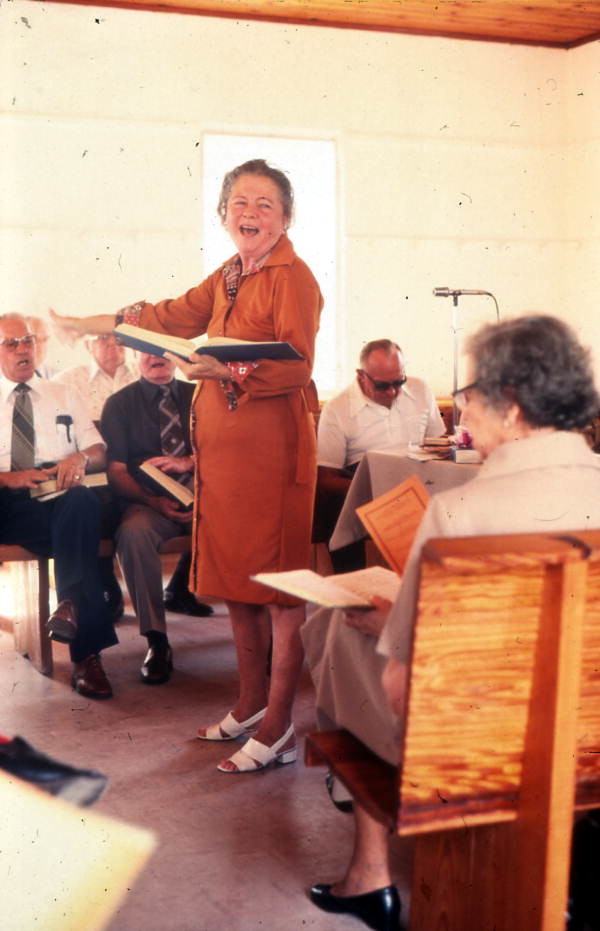The Sacred Harp
Rebecca Spears
 It’s the sacred harp—the voice. It’s also the eponymous title of a choral music book, first published in 1844. What’s odd about this book is that the music within it, from traditional hymns, appears in shape notes: Fa, a triangle; Sol, an oval; La, rectangle; and Mi, diamond. The book reflects a style of choral hymn singing, associated with the American South. Except now, it’s making a comeback, not only in the South, but in New England, the Midwest, and the West, as well as in Europe and Australia.
It’s the sacred harp—the voice. It’s also the eponymous title of a choral music book, first published in 1844. What’s odd about this book is that the music within it, from traditional hymns, appears in shape notes: Fa, a triangle; Sol, an oval; La, rectangle; and Mi, diamond. The book reflects a style of choral hymn singing, associated with the American South. Except now, it’s making a comeback, not only in the South, but in New England, the Midwest, and the West, as well as in Europe and Australia.
In July, two friends and I had gone to visit the Pineywoods Herb Farm in Kennard, in East Texas. Driving into Kennard, one friend called attention to a wayside sign in front of a plain, clapboard building with a wide garage: “Sacred Harp Singing, Tuesday. Covered dish supper 6 – 7 pm. Singing 7 – 8 pm.” A second sign attached to the building itself read “Kennard Auto Service.” My two friends had heard of such singing before, but didn’t really know what it was. For me, it was a complete mystery. And why was it at the Kennard Auto Service building?
As I soon discovered, monthly Sacred Harp singings take place regularly in East Texas, where the tradition has thrived for many years, although now the singings occur in all the major Texas cities, including Houston, Dallas, Austin, and San Antonio. The East Texas Sacred Harp Convention (founded in 1855) is one of two of the oldest organizations in the country; the other is the Chattahoochee Musical Convention (Georgia, 1852). The singings in Kennard occur monthly in the old Kennard Auto Service building, which Jerry and Margaret Wright, bought and renovated inside as a singing venue. They decided to keep building’s original name, because people in the area know the structure by that name.
What has made Sacred Harp singings so enduring and pleasurable? Well, for one thing, the singer doesn’t need to be near-perfect or near-professional. Pitch isn’t absolute; it’s moveable to accommodate the voice of the song leader. The shape notes also help the average singer, who may not be familiar with a tune, to sight read. These singings are democratic; they’re participatory, reflective of the structure of many American Christian sects. Each part—treble, alto, tenor, and bass—is “singable” and “tuneful” by itself. The tune is often carried by the tenors, deemphasizing the melody that in traditional hymnody is carried by the highest notes (the trebles). The detail that has fired my imagination is the arrangement of the singers. Because the singings aren’t for an audience, but for the singers themselves, the four sections are seated in the hollow-square arrangement:
In this arrangement, singers often experience the power of their singing intensely. The singers take turns leading the hymns, and inside the square’s hollow is the greatest experience, participants say. All the voices, usually in harmonies of fourths and fifths, sing toward the song leader, lifting up their voices to God. The power of their singing becomes a felt experience of joyful noise. I have been listening to clips of Sacred Harp singing at texasfasola.org, fasola.org, and YouTube, and I feel drawn to it. You see, I am a failed choir member who loves to sing (I’ll tell that story another time). I believe Sacred Harp singing might just be where I fit in and I have hopes of attending a singing this fall. Stay tuned.